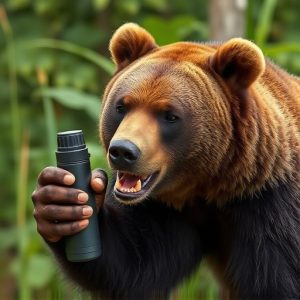Stay Safe: Mastering Wilderness Defense Against Grizzly Bears & TSA Bear Spray Rules
Grizzly bears in North America require understanding their feeding patterns and adhering to TSA rule…….
Grizzly bears in North America require understanding their feeding patterns and adhering to TSA rules for bear spray for safe exploration. The TSA permits carrying up to 3.4 ounces of bear spray in a clear, quart-sized bag in a hard-sided container. Proper usage involves targeting the bear's face, eyes, and nose as a last resort after escape attempts. After encounters, move to secure locations, assess injuries, and follow storage and use instructions from the manufacturer. Seek medical attention for significant exposure or wounds, while minor injuries may heal on their own under professional evaluation if necessary.
“Venturing into wilderness areas comes with an inherent risk of encountering grizzly bears. Understanding their behavior and arming yourself with the right tools are essential for safety. This guide delves into critical aspects of bear encounters, focusing on ‘Tsa Rules for Bear Spray’ – a crucial defense mechanism. From recognizing bear signals to post-encounter care, you’ll learn effective strategies to navigate potential dangers in the wild. Equip yourself with knowledge and stay safe during your outdoor adventures.”
- Understanding Grizzly Bear Behavior: Key Factors to Know
- Tsa Rules for Bear Spray: What You Need to Know Before Heading Out
- Effective Wilderness Defense Techniques When Confronted by a Grizzly
- Post-Encounter Safety Measures and When to Seek Medical Attention
Understanding Grizzly Bear Behavior: Key Factors to Know
Grizzly bears, powerful and formidable creatures, are an integral part of North America’s wilderness. Understanding their behavior is crucial when venturing into their habitat. Key factors to know include their feeding patterns; grizzlies are opportunistic foragers, often seeking out the easiest sources of food, like salmon in streams or berries on open slopes. They also have a strong sense of smell and can detect potential prey or threats from great distances.
Knowing the Tsa (US Fish and Wildlife Service) Rules for Bear Spray is essential for safety when in grizzly bear country. Bear spray is a deterrent that can provide crucial time to escape if a bear charges. It’s important to understand the proper usage, range, and limitations of bear spray as it may not always guarantee a safe outcome. Always carry it when recommended by local authorities and practice using it before venturing into potential bear encounters.
Tsa Rules for Bear Spray: What You Need to Know Before Heading Out
Before venturing into wilderness areas where grizzly bears roam, understanding the TSA rules for bear spray is crucial. The Transportation Security Administration (TSA) has specific guidelines regarding the transport of bear spray as a safety measure for all travelers. These rules ensure that bear spray is handled and stored properly to prevent any hazards during flights or at security checkpoints.
Bear spray is considered an acceptable item for carry-on luggage, but it must adhere to strict size and packaging requirements. The TSA allows up to 3.4 ounces (100 ml) of bear spray in a clear, quart-sized plastic bag. Additionally, the spray should be stored in a secure container, typically a hard-sided container that prevents leakage or accidental discharge. Always check with your airline for any additional policies or restrictions before packing and traveling with bear spray.
Effective Wilderness Defense Techniques When Confronted by a Grizzly
When faced with a charging grizzly bear in the wilderness, understanding effective defense techniques is crucial for your safety. One of the primary tools recommended by experts and regulated by the TSA (Transportation Security Administration) rules for bear spray is pepper spray specifically designed for bears. This potent spray can create enough distance to allow you to escape or retreat to safety. It’s important to ensure the spray is accessible, as bears can charge at unpredictable speeds.
Additionally, knowing the Tsa Rules for Bear Spray involves understanding its proper usage and range. Aiming for the bear’s face, eyes, and nose, if possible, will maximize its effectiveness. Keep in mind that the spray should be used as a last resort when all other escape routes are blocked. Practice using bear spray regularly to familiarize yourself with its mechanics and ensure it becomes an automatic reaction during an encounter.
Post-Encounter Safety Measures and When to Seek Medical Attention
After a bear encounter, it’s crucial to take immediate safety precautions to prevent further interaction. If you’ve successfully avoided or defended against an attack, move to a secure location far from the bear’s path and assess your injuries if any. Bear spray, as per TSA rules, should be stored and used according to manufacturer instructions. Keep in mind that if you’ve been exposed to bear saliva or have sustained significant lacerations or puncture wounds, immediate medical attention is required.
Seeking professional help is essential for deep or infected cuts, as well as for monitoring potential symptoms of hyperglycemic hypovolemic shock, a condition that can arise from severe stress and physical trauma. While minor scratches and bruises may heal on their own, it’s advisable to consult a healthcare provider if you experience persistent pain, redness, or swelling.
When navigating wild landscapes, understanding grizzly bear behavior and adhering to TSA rules for bear spray are essential components of your safety arsenal. Armed with knowledge and the right tools, you can effectively defend yourself should a grizzly encounter occur. Remember, prevention is key; always practice responsible wilderness etiquette and store bear spray properly. In the unlikely event of an attack, promptly utilize your spray and employ defense techniques taught by experts. After any bear encounter, take necessary safety measures to monitor for potential injuries and seek medical attention if required. Stay informed, stay safe, and respect the power of nature’s wild inhabitants.


